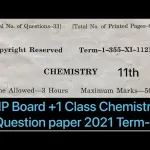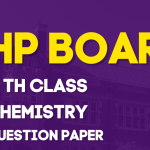Chemistry in the 11th standard introduces students to crucial concepts that build the foundation for advanced studies. This guide provides important questions and their answers to help students prepare for the 2019 quarterly exams.
Important Questions and Answers for Chemistry
Question What is the atomic number of an element, and how is it represented?
Answer The atomic number is the number of protons in the nucleus of an atom. It is represented as ‘Z.’
Question Define isotopes with an example.
Answer Isotopes are atoms of the same element with the same atomic number but different mass numbers. Example: Carbon-12 and Carbon-14.
Question What is the significance of the periodic table?
Answer The periodic table organizes elements based on their properties and atomic numbers, helping in understanding their behaviors.
Question Explain the term “mole” in chemistry.
Answer A mole is a unit that measures the amount of substance containing Avogadro’s number of particles (6.022 × 10²³).
Question What are valence electrons?
Answer Valence electrons are the electrons in the outermost shell of an atom that participate in chemical bonding.
Question State the octet rule.
Answer The octet rule states that atoms tend to combine to form molecules by gaining, losing, or sharing electrons to achieve eight electrons in their outermost shell.
Question What is the difference between ionic and covalent bonds?
Answer Ionic bonds are formed by the transfer of electrons, while covalent bonds are formed by the sharing of electrons between atoms.
Question Define electronegativity.
Answer Electronegativity is the tendency of an atom to attract a shared pair of electrons towards itself in a chemical bond.
Question What is Avogadro’s law?
Answer Avogadro’s law states that equal volumes of gases at the same temperature and pressure contain an equal number of molecules.
Question What are acids and bases according to the Arrhenius concept?
Answer Acids release H⁺ ions in an aqueous solution, while bases release OH⁻ ions in an aqueous solution.
Question What is the pH scale?
Answer The pH scale measures the acidity or alkalinity of a solution, ranging from 0 to 14, where 7 is neutral.
Question Write the chemical formula for sodium carbonate.
Answer The chemical formula for sodium carbonate is Na₂CO₃.
Question Define empirical formula and molecular formula.
Answer The empirical formula gives the simplest whole-number ratio of elements in a compound, while the molecular formula gives the actual number of atoms of each element.
Question What are alkali metals? Give two examples.
Answer Alkali metals are elements in Group 1 of the periodic table. Examples: Sodium (Na) and Potassium (K).
Question What is the general formula for alkanes?
Answer The general formula for alkanes is CₙH₂ₙ₊₂.
Question Explain the law of conservation of mass.
Answer The law states that mass cannot be created or destroyed in a chemical reaction.
Question What is meant by hydration energy?
Answer Hydration energy is the energy released when ions are surrounded by water molecules.
Question State the first law of thermodynamics.
Answer The first law of thermodynamics states that energy cannot be created or destroyed, only transformed from one form to another.
Question What is the difference between endothermic and exothermic reactions?
Answer Endothermic reactions absorb heat, while exothermic reactions release heat.
Question What is a buffer solution?
Answer A buffer solution resists changes in pH when small amounts of acid or base are added.
Question Define hybridization in chemistry.
Answer Hybridization is the process of mixing atomic orbitals to form new hybrid orbitals suitable for bonding.
Question What is the principle of chromatography?
Answer Chromatography separates components of a mixture based on their different rates of movement through a medium.
Question What are greenhouse gases? Give two examples.
Answer Greenhouse gases trap heat in the atmosphere. Examples: Carbon dioxide (CO₂) and methane (CH₄).
Question Define a catalyst.
Answer A catalyst is a substance that speeds up a chemical reaction without being consumed in the process.
Question What are transition elements? Give one example.
Answer Transition elements are d-block elements that exhibit variable oxidation states. Example: Iron (Fe).
Question Explain Le Chatelier’s principle.
Answer Le Chatelier’s principle states that if a system at equilibrium is disturbed, it will adjust to minimize the disturbance.
Question What is an alloy? Give an example.
Answer An alloy is a mixture of two or more metals or a metal and a non-metal. Example: Brass (Copper and Zinc).
Question Define periodicity in the periodic table.
Answer Periodicity refers to the repeating trends in the properties of elements across different periods and groups.
Question What is the IUPAC name for CH₃CH₂OH?
Answer The IUPAC name for CH₃CH₂OH is ethanol.
Question What is the role of water as a solvent?
Answer Water dissolves many substances due to its polarity, making it a universal solvent.
Question What are noble gases? Give two examples.
Answer Noble gases are inert elements in Group 18 of the periodic table. Examples: Helium (He) and Neon (Ne).
Question Write the formula of ammonia and its molar mass.
Answer The formula of ammonia is NH₃, and its molar mass is 17 g/mol.
Question What is meant by isomerism?
Answer Isomerism occurs when compounds have the same molecular formula but different structures.
Question Define oxidation and reduction.
Answer Oxidation is the loss of electrons, while reduction is the gain of electrons.
Question What is the common ion effect?
Answer The common ion effect suppresses the ionization of a weak electrolyte by the presence of a strong electrolyte with a common ion.
Question Explain the term “stoichiometry.”
Answer Stoichiometry involves the calculation of reactants and products in a chemical reaction based on the balanced equation.
Question What are heteroatoms? Give an example.
Answer Heteroatoms are atoms other than carbon and hydrogen in organic compounds. Example: Oxygen in ethanol.
Question What is electrolysis?
Answer Electrolysis is the process of using electricity to drive a chemical reaction.
Question Explain the difference between a solute and a solvent.
Answer A solute is the substance that dissolves, while a solvent is the medium in which the solute dissolves.
Chemistry is an exciting subject that combines theoretical concepts with practical applications. Reviewing these questions helps students grasp essential topics and prepare effectively for their exams
Latest Posts
- Step-by-step guide to download and apply for jee mains admit card 202
- Comprehensive 2025 government holidays and recruitment details for job seekers
- JEE Mains Admit Card 2025: Your Step-by-Step Guide to Downloading the Hall Ticket
- Everything You Need to Know About 2025 Government Holidays Recruitment
- Comprehensive Guide to rrb d group recruitment 2025 – Eligibility, Vacancies, and Application
- Detailed guide to nps trust recruitment 2025 vacancies, eligibility and apply process
- Comprehensive guide to hpcl recruitment 2025 notification, vacancies, and application process
- ignou bed admission 2025 complete recruitment guide with eligibility and process
- Comprehensive Guide to Indian Army Agniveer Recruitment 2025 Notification and Jobs
- Everything You Must Know About CBSE Board Exams 2025 Changes & New Rules





